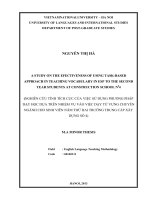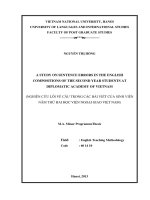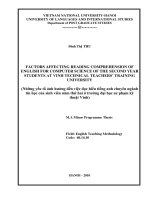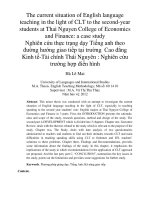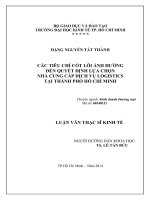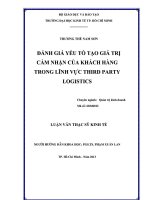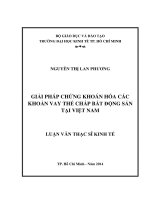(Luận văn thạc sĩ) a study on english learning goals and motivation of the second – year students at military academy of logistics
Bạn đang xem bản rút gọn của tài liệu. Xem và tải ngay bản đầy đủ của tài liệu tại đây (1.21 MB, 67 trang )
VIETNAM NATIONAL UNIVERSITY, HANOI
UNIVERSITY OF LANGUAGES AND INTERNATIONAL STUDIES
FACULTY OF POST-GRADUATE STUDIES
***************************
ĐÀO NGUYỄN THÚY HÀ
A STUDY ON ENGLISH LEARNING GOALS AND
MOTIVATION OF THE SECOND – YEAR STUDENTS AT
MILITARY ACADEMY OF LOGISTICS
(Nghiên cứu về mụ ti u v
si h vi
g
học tiếng Anh của
ăm hai tại Học viện Hậu cần)
M.A. MINOR PROGRAMME THESIS
Field
: English Teaching Methodology
Code
: 60140111
HANOI, 2016
VIETNAM NATIONAL UNIVERSITY, HANOI
UNIVERSITY OF LANGUAGES AND INTERNATIONAL STUDIES
FACULTY OF POST-GRADUATE STUDIES
ĐÀO NGUYỄN THÚY HÀ
A STUDY ON ENGLISH LEARNING GOALS AND
MOTIVATION OF THE SECOND – YEAR STUDENTS AT
MILITARY ACADEMY OF LOGISTICS
(Nghiên cứu về mụ ti u v
si h vi
g
học tiếng Anh của
ăm hai tại Học viện Hậu cần)
M.A. MINOR PROGRAMME THESIS
Field
: English Teaching Methodology
Code
: 60140111
Supervisor : Asso . Prof. Dr. L Vă Ca h
HANOI, 2016
DECLARATION
I certify that this thesis is entirely my own work. Documented references
have been fully provided. I have not been submitted this thesis for assessment in
any other formal course of study.
Hanoi, 2016
Đ o Nguyễn Thúy Hà
i
ACKNOWLEDGEMENTS
First and foremost, I would like to acknowledge with great attitude to the
support, guidance and invaluable critical feedbacks which I have received from my
supervisor Dr. Le Van Canh in completion of this research.
I would also like to express my thankfulness to all the teachers at English
Department, Military Academy of Logistics (MAL) for their help in completing the
survey questionnaire as well as for their willingness to share the ideas on the
accomplishment of the study.
My sincere thanks are also extended to the second – year students at MAL
who have actively participated in the study when I collected the data for this thesis.
Without their help, this project could not have been completed.
Last but not least, I would like to express my heartfelt gratitude to the
members of my family who have constantly supported, inspired and encouraged me
to carry out the thesis.
Hanoi, 2016
Đ o Nguyễn Thúy Hà
ii
ABSTRACT
This study is aimed at investigating learning goals and motivation of the
second- year students in learning English at Military Academy of Logistics, Hanoi.
The main purposes of this study were to find out: (1) the student‟s learning goals
regarding English learning; (2) the relationship between learning goals and
motivation.
The subjects of this study were 120 second – year students at Military
Academy of Logistics. These students were invited to answer the questionnaire and
some of them joined in the interview.
The study consists of three main parts. The first one is an introduction
including the rationale, aims, research questions, significance, scope, methods, and
design of the study. The second part contains four chapters. Chapter I focuses on the
theoretical background of the study, which is about learning goals and motivation.
Chapter II is about the methodology of the study. Chapter III deals with data
analysis. Chapter IV presents major findings based on data analysis. The last past
offers the summary of the study, limitations and suggestions for further research.
iii
LIST OF CHARTS AND TABLES
Table 1: Common Reference Levels: self-assessment grid (Level B1)
Table 2: Common Reference Levels: Qualitative aspects of spoken language use.
Table 3: Student‟s goals toward learning Speaking skill
Table 4: Student‟s goals toward learning Listening skill
Table 5: Student‟s goals toward learning Writing skill
Table 6: Student‟s goals toward learning Reading skill
Table 7: The frequency distribution of items measuring extrinsic motivation
(n = 120)
Table 8: The frequency distribution of items measuring intrinsic motivation (n=120)
Table 9: Student‟s desire to learn English
Chart 1: Students‟ level of English
Chart 2: Frequency distribution of items measuring extrinsic motivation
Chart 3: Frequency distribution of items measuring intrinsic motivation.
Chart 4: Students‟ attitude toward English learning
Chart 5: Students‟ attitude toward the need of English learning
iv
ABBREVIATIONS
L2:
Second language
MAL:
Military Academy of Logistics
SDT:
Self-determination theory
SD:
Strongly Disagree
D:
Disagree
U:
Undecided
A:
Agree
SA:
Strongly Agree
v
TABLE OF CONTENTS
DECLARATION ............................................................................................... i
ACKNOWLEDGEMENT....... .......................................................................... ii
ABSTRACT ....................................................................................................... iii
LIST OF TABLES............................................................................................. iv
ABBREVIATIONS............................................................................................ v
INTRODUCTION........................................................ .............................. 1
1. Rationale of the study .................................................................................... 1
2. Aims of the study ........................................................................................... 2
3. Research questions ........................................................................................ 2
4. Significance of the study ................................................................................ 2
5. Scope of the study .......................................................................................... 2
6. Design of the study ......................................................................................... 3
DEVELOPMENT.......................................................... ............................. 5
CHAPTER I: LITERATURE REVIEW............................................................5
1.1. Definition of learning goals and motivation.............................................. 5
1.1.1. Learning goals............................................................................................. 5
1.1.2. Motivation............................................................................. ...................... 6
1.1.3. Adopting the Common European Framework (CEFR) at Military Academy
of Logistics……………………………………………… .................................... 8
1.2. Motivational theory........................................................ .............................. 11
1.2.1. Intrinsic motivation............................................... ..................................... 11
1.2.2. Extrinsic motivation.................................................................................... 12
1.3. The relationship between learning goals and motivation........... ............... 14
vi
1.3.1. Expectancy – value theory............................................... ........................... 14
1.3.2. Achievement goal theory.............................................. .............................. 14
1.3.3. Self-determination theory....................................... .................................... 17
CHAPTER 2 : METHODOLOGY........................................... ......................... 20
2.1. Context of the study........................................................ .............................. 20
2.2. Subjects of the study.............................................................. ....................... 21
2.3. Data collection instruments.......................................................................... 22
2.4. Data collection procedures.................................................................... ....... 23
2.5. Data analysis........................................................................................... ....... 24
CHAPTER 3: FINDINGS AND DISCUSSIONS....................................... ....... 26
3.1. Learning goals and motivation..................................................................... 26
3.2. The relationship between learning goals and motivation.................. ........ 36
3.3. Summary of the chapter........................................................................ ....... 39
CONCLUSION............................................................................. .............. 41
1. Summary of the findings and discussions...................................... ................ 41
2. Limitations................................................................................ ........................ 42
3. Future direction.................................................................. ............................. 43
REFERENCES.................................................................. .................................. 45
APPENDIX.................................................................. ........................................ I
Appendix 1: SURVEY
QUESTIONNAIRE.................................................................. ........................... I
Appendix 2: INTERVIEW QUESTIONS.......... .............................................. IX
Appendix 3: Schmidt et al. (1996) intrinsic-extrinsic motivational
questionnaire...................................................................................................... XI
vii
PART A: INTRODUCTION
1. Rationale for the study
In the globalization era, English has become more and more important as an
international language; therefore, in many countries all over the world, students are
requires to learn English through compulsory programmes at educational
institutions. In correspondence to this trend, the importance of English as a
language of international communication has been acknowledged by the
government, English teaching and learning have been given more and more priority
in Vietnam. According to Canh (2004, p.167), learning English can “contribute to
students‟ personal, linguistic, social, and culture development”. The study of
Dornyei (2001) has shown that there are many factors involved in setting learning
goals and motivation. That‟s why the influences of learning goal and motivation on
learning English should be investigated carefully to solve the above-mentioned
problem.
In the process of teaching and learning English, motivation and setting goals, as
indicated by research, are two essential elements in learning the second/ foreign
language. Furthermore, as a lecturer of English at Military Academy of Logistics, I
have realized that although English is considered one of the main subjects at
Military Academy of Logistics (MAL) with a lot of time and effort spent on
learning, most of students in general and the second – year students in particular
seem not to be successful in learning English. After I talk with those students as
well as observation, most of them lack of motivation and do not set their own
learning goal during the process of learning. However, up to now, there has not
been any research conducted to investigate into this issue at MAL.
1
This is the reason why I choose “A study on learning goals and motivation of the
second-year students in learning English at Military Academy of Logistics.” is
the topic for my minor thesis. It is hoped that this study will figure out a concrete
picture of learning goals and motivation of the second- year students at MAL,
which can help teachers who want to motivate their students in learning English.
2. Aims of the study
The aims of the study are to investigate the factors affecting learning goals and
motivation of the second-year students in learning English at Military Academy of
Logistics. The main purpose covering the study is to identify how students’
learning goals are related to their motivation.
3. Research questions
To achieve these aims, the study sets out to answer the following research
questions:
1. What are the students’ learning goals regarding English learning?
2. To what extent are their learning goals related to their motivation in
learning English?
4. Significance of the study
The study indicates types of learning goals and motivation which are possessed by
most of the second-year students at Military Academy of Logistics, which is of
benefit to English teachers at this university. It also describes the factors affecting
the learning goals and motivation. Furthermore, it shows the relationship between
learning goals on motivation of the students. Hopefully, this study can help their
English learning as well as the teachers to upgrade their teaching methods.
2
5. Scope of the study
There are three levels of training at Military Academy of Logistics named as
College level, Junior College level and Vocational Training level. Within its scope,
the study is limited only to the second – year students at College level.
Learning goals and motivation as well as their effects on the second language have
been paid attention by many researchers. In fact, it is a broad topic with many
different aspects. Thus, because of the limited time and within an M.A minor thesis,
I limited myself to focus on making a brief view of the second-year students‟
learning goals and their motivation in English learning as well as the factors
affecting them. The reason I choose the second-year students for this study is that at
that time they start the English course at school. In term of the students‟ motivation,
I also intend to focus on the intrinsic and extrinsic motivation.
6. Design of the study
The thesis consists of three parts: the introduction, the development, and the
conclusion.
Part One – Introduction: provides rationales, aims of the study, research
questions, significance, and the scope of the study and its design.
Part Two – Development: is organized around three chapters as follows:
Chapter 1: Literature review: conceptualizes the framework of the study
through the discussion of the issues and ideas on theories of learning goals and
motivation, and the relationship between them.
Chapter 2: Methodology: presents the context, the methodology used in this
study including the subject, the data collection instruments, data collection
procedure, and data analysis.
3
Chapter 3: Findings and Discussions: consists of a comprehensive analysis
of the data and a discussion on the findings of this study.
Part Three – Conclusion: offers a summary of the findings, recommendations,
limitation, and future directions for further study.
4
PART A: DEVELOPMENT
CHAPTER 1: LITERATURE REVIEW
1.1. Definition of learning goals and motivation
1.1.1. Definition of learning goal
Goal Theory is a social-cognitive theory of achievement motivation developed by
Dweck (1986). Goal Theory became a particularly important theoretical framework
in the study of academic motivation in the late 1980s. Whereas other motivational
theories examine students' beliefs about their successes and failures, goal
orientation theory examines the reasons why students engage in their academic
work.
Miyamoto and Nasu (1995) states that individual behaviors are thought to be
rational and economic so as to achieve certain goals. Therefore, based on what kind
of goals an individual student has, Goal Theory can be used to make predictions
about that student‟s learning behavior and learning outcome (Dweck, 1986).
Latham and Locke (2006) highlight “a goal is a level of performance proficiency
that we wish to attain, usually within a specified time period. Thus goal setting is
first and foremost a discrepancy-creating process, in that the goal creates
constructive discontent with our present performance”. Accordingly, goals that are
specific and challenging lead to better performance than goals that are vague such
as doing your best. They also indicate that when people are confronted with a goal,
they tap into their knowledge and skills; they use deliberate planning, and develop
task strategies using both cognitive and behavior mechanisms that serve to direct
attention and effort towards goal relevant activities (Latham & Locke, 2002).
5
Harmer (1991, p.3), categorizes the goal in second language learning into two
types: (1) short-term goal means when students wish to succeed in doing something
in the near future, for example, students who want to pass their examination or to
get good grade or high score; and (2) long-term goal refers to a wish of students or
learners who want to get a better job in the future or to be able to communicate with
people who use the language that they study or the target language.
In one of the earliest attempts to link personality to the goal setting process,
Campbell (1982) suggested that personality factors could affect several aspects of
goal-setting behavior: (1) the propensity to set goals; (2) the content of the goals set;
(3) the stability of set goals over time; (4) the typical specificity of goals set; and (5)
the typical difficulty of goals set.
1.1.2. Motivation
The word “motivation”, coined from Latin word “movere”, is understood as the
forces that make one do something. Motivation has been perhaps one of the most
popular research topics since the beginning of the 20th century, which attracts a lot
of attention of researchers both in psychological and educational field. All the
motivation theories in general want to explain the fundamental question of why
humans behave as they do, and therefore we cannot assume any simple and
straightforward answer.
Gardner (1985, p.10), in his socio-educational model, notes that “motivation refers
to the combination of effort plus desire the goal of learning the language plus
favorable attitudes towards learning language”. He chooses to define motivation by
specifying three aspects of motivation: (1) effort refers to the time spent studying
the language and the drive of the learner; (2) desire indicates how much the
6
learner wants to become proficient in the language, and (3) affect means the
learner‟s emotional reactions related to language study (Gardner, 1985, p.13).
Crookes and Schmidt (1991) give their viewpoint of motivation including both
internal and external aspects. Internal aspects consist of interest level, perception of
relevance, expectancy of success or failure, and perception of reward. On the other
hand, external aspects include the overt decision to learn and persistent learning
behavior and high involvement. As a result, learning is only effective if students
enjoy activities and word hard.
According to Lightbrown and Spada (1999), motivation in second language learning
is a complex phenomenon which can be defined in term of two factors: learners‟
communicative needs and their attitudes towards the second language community.
The author explain that if learners need to speak the second language in a wide
range of social situations or fulfill professional ambitions, they will perceive the
communicative value of L2 and will therefore be motivated to acquire proficiency
in it. Likewise, if learners have favorable attitudes towards the speakers of the
language, they will desire more contact with them.
Malone (1981) defines motivation in terms of the challenge of the activities or tasks
conducted by the teacher. According to him, challenge depends on activities that
meet the needs of students‟ different levels. The tasks or activities which are too
easy or too difficult will de-motivate students. On the contrary, if student find the
activities challenging enough, they will be more interested, which leads to effective
learning.
Another concept of motivation stated by Dornyei (2001, p. 61) is that motivation as
“a general ways of referring to the antecedents”. He also argues that the learning of
7
a second language is dependent upon the learners‟ willingness to identify with the
culture of the target language and to incorporate aspects of the target language
culture into his or her own behavior (2001, p.7). The author mentions two
dimensions of human behavior: direction and magnitude which motivation
concerns.
In brief, each approach to motivation reflects a different perspective from which L2/
foreign language learning motivation is conceptualized. However, generally
speaking, most of the researchers have identified three crucial components of
motivation: (1) the conscious decision directed to the goal of learning a language,
(2) the effort expanded to achieve that goal, and (3) the sustenance of the
goal/effort.
1.1.3. Adopting the Common European Framework (CEFR) at Military Academy
of Logistics.
The CEFR for languages was developed by the Council of Europe over more than
20 years before being officially launched during the European Year of Languages in
2001. Since then the CEFR has grown in popularity both in Europe and across the
world.
The framework is used to benchmark communicative language ability in reading,
writing, speaking and listening. The CEFR is divided into 3 levels; basic users
(Level A), independent users (Level B) and proficient users (Level C).
Military Academy of Logistics (MAL) has set Level B1 as English language
proficiency target for the students from the second year to the pre-graduation time
since 2013.
8
Table 1 and Table 2 show the framework at Level B1 which students have to
achieve.
Table 1: Common Reference Levels: self-assessment grid (Level B1)
I can understand the main points of clear standard
speech on familiar matters regularly encountered in
UNDESTANDING
work, school, leisure, etc. I can understand the main
Listening
point of many radio or TV programs on current affairs
or topics of personal or professional interest when the
delivery is relatively slow and clear.
I can understand texts that consist mainly of high
frequency everyday or job related language. I can
Reading
understand the description of events, feelings and
wishes in personal letter.
I can deal with most situations and likely to arise while
Spoken
traveling in an area where the language is spoken. I can
interaction
enter unprepared into conversation on topics that are
familiar, of personal interest or pertinent to everyday
SPEAKING
life (e.g. family, hobbies, work, travel and current
events)
I can connect phrases in simple way in order to
describe experiences and events, my dreams, hopes and
Spoken
ambitions. I can briefly give reasons and background
production
and my present explanations for opinions and plans. I
can narrate a story or relate the plot of a book or a film
9
and describe my reactions.
I can write simple connected text on topics which are
WRITING Writing
familiar or of personal interest. I can write personal
letters describing experiences and impressions
Table 2: Common Reference Levels: Qualitative aspects of spoken language use.
Have enough language to get by, with sufficient vocabulary to
express him/ herself with some hesitation and circumlocutions
RANGE
on topics such as family, hobbies and interest, work, travel and
current events.
Use reasonable accurately a repertoire of frequently used
ACCURACY
“routines” and patterns associated with more predictable
situations.
Can keep going comprehensibly, even though pausing for
FLUENCY
grammatical and lexical planning and repair is very evident,
especially in longer stretches of free production.
Can initiate, maintain and close simple face to face conversation
on topics that are familiar or of personal interest. Can repeat
INTERACTION back part of what someone has said to confirm mutual
understanding.
Can link a series of shorter, discrete simple elements into a
COREHENCE
connected, linear sequence of points.
10
1.2. Motivation theory
The theories of motivation developed during the cognitive-situated period, although
certainly distinct from those described above, nevertheless do not negate that social
psychological work. Rather, those foundations are still accepted, and the newer
perspectives about how motivation functions in the real world (e.g. in classrooms)
can be studied in conjunction with the earlier models (Dörnyei, 2005).
1.2.1. Intrinsic motivation
Intrinsic motivation, based in autonomy and competence, describes a situation in
which material is engaged in for its inherent interest and the satisfaction and
enjoyment it engenders. An example would be a person who enjoys learning a
language because of the satisfaction felt when new concepts are mastered
(competence) or because of the inherent interest and joy associated with learning
the language.
In other words, intrinsic motivation refers to motivation that comes from inside an
individual rather than from any external or outside rewards, such as money or
grades. The motivation comes from the pleasure one gets from the task itself or
from the sense of satisfaction in completing or even working on the task. An
intrinsically motivated student may want to get s good grade on an assignment, but
if the assignment does not interest that student, the possibility of a good grade is not
enough to maintain his or her motivation to put any effort into the project.
Furthermore, Dornyei (2001) subdivides intrinsic motivation into three subtypes:
(1) intrinsic motivation to know refers to motivation for “engaging in an activity for
the pleasure and satisfaction of understanding something new, satisfying one‟s
curiosity and exploring the world” (p.28), (2) intrinsic motivation toward
11
achievement is the feeling of satisfaction associated with attempting to surpass
oneself, to cope with challenges and to accomplish or to create something, in other
words, it indicates the effort to realize the goal or master a task, and (3) intrinsic
motivation to experience stimulation is the type of motivation to engaging in an
activity to experience pleasant sensations stimulated by the activity itself (Dornyei,
2001, p. 149)
1.2.2 Extrinsic motivation
Extrinsic motivation can be regarded as the opposite of intrinsic motivation. The
goal connected with intrinsic motivation is a positive learning effect that lasts long
time, but the goal of an extrinsically motivated student is completely different.
Dornyei (2001, p.27) stated that extrinsic motivation involves performing behaviour
as a means to an end, that is, it originated outside the individual and is concerned
with external environmental factors that help shape students‟ behaviour.
An extrinsically motivated person will work on a task even when they have a little
interest in it because of the anticipated satisfaction they will get from some reward.
The rewards can be something as minor as a smiley face to something major like
fame or fortune. For example, in the case of a student, the reward would be a good
grade on and assignment or in the class. He or she may dislike an assignment, may
find it boring, or may have interest in the subject, but the possibility of a good grade
will be enough to keep the student motivated in order for him or her to .put forth the
effort to do well on a task.
Self – determination theory also proposes that extrinsic motivation can vary greatly
in the degree to which it is antonymous. For instance, a student who does his
homework only because he fears parental sanctions for not doing it is extrinsically
12
motivated. Similarly, a student does the work because he personally believes it is
valuable for his chosen career. Both examples involve instrumentalities, yet the
latter case entails personal endorsement and a feeling of choice, whereas the former
involves mere compliance with an external control.
Like intrinsic motivation, according to Dornyei (2001), extrinsic motivation is
divided into four subtypes: (1) external regulation refers to “the least selfdetermined form of extrinsic motivation, coming entirely from external sources
such as rewards or threat” (p.28), for example, a student with external regulation
may learn English because his parents ask him to learn or his teacher encourages
him to learn; (2) interjected regulation involves “ externally imposed rules that
student accepts as norms to be followed in order not to feel guilty” (p.28), for
instance, an interjected student may do his homework because he feels guilty if he
does not do so; (3) identified regulation occurs when the student engages in an
activity as he highly values and identifies with the behaviour, and see it useful to do,
a student with the identified regulation may learn English because it is necessary for
him to listen to English songs or watch films in English.; lastly (4) integrated
regulation indicates “choiceful behaviour that is fully assimilated with the
individual‟s other values, needs and identity” (p.28). An example is that a student
learns English because he thinks English proficiency is a part of an educated
cosmopolitan culture that everyone in his country must adopt.
According to Brown (2000), intrinsic and extrinsic motivation can be easily
identified in foreign language classrooms regardless of the differences between the
cultural beliefs and the attitudes of learners and teacher. In addition, Schmidt (1996)
13
concluded that intrinsic – extrinsic distinction is similar to integrative – instrumental
distinction but not identical.
In scope of this study, due to the limitation of M.A minor thesis, I only focus on
investigating to find out the intrinsic/extrinsic motivation which is possessed by the
second – year students at MAL.
1.3. The relationship between learning goals and motivation
1.3.1. Expectancy – value theory
Eccles (1983) defined and measured expectancies for success as children‟s beliefs
about how well they will do on upcoming tasks, either in the immediate or longer
term future. Ability beliefs are de-fined as the individual‟s perception of his or her
current competence at a given activity. Ability beliefs thus are distinguished
conceptually from expectancies for success, with ability beliefs focused on present
ability and expectancies focused on the future.
Expectancies focus on future success and, as such, are distinct from, although
related to, ability beliefs, which focus on present ability (Wigfield & Eccles, 2002).
Subjective task values refer to the “quality of the task that contributes to the
increasing or decreasing probability that an individual will select it” (Eccles, 2005,
p. 109). Expectancies and values are influenced by the individual‟s goals and
general self-schema (short- and long-term goals, self-concept and ability beliefs,
and perceptions of task difficulty). Values are also influenced by the individual‟s
affective reactions. More distally, past performance and aptitude, as well as the
socializers‟ expectations and behaviors, influence these goals, self-schema, and
affective reactions.
14
1.3.2. Achievement goal theory
Achievement goals are competence-based aims that individuals target in evaluative
settings. Originally, two distinctive achievement goals were identified based on the
definition of personal competence: mastery and performance goals (Dweck &
Leggett, 1988).
Specifically, mastery goals reflect perceived competence in terms of absolute
evaluative standards or task master. When someone is task-involved, her primary
goal is learning and mastery of the task for its own sake. Task involvement appears
when the student is intrinsically interested in the activity and judges herself in a
self-referenced manner. Therefore, task oriented goals rely on comparisons with
requirements of the task and/or internal comparisons with one‟s past attainment or
one‟s maximum potential attainment. There is a focus on effort and improvement.
According to Dweck (1989), individuals displaying a master goal orientation are
more likely to seek challenging situations, regardless of their perceived level of
ability or expectations of success. Even when faced with failure, mastery goal
oriented individual view the situation as a learning opportunity for personal growth
(Bandura & Dweck, 1985). In this context, failure is seen as useful feedback simply
meaning that the current strategy is insufficient for the particular task and that more
effort and ingenuity is needed for mastery (Elliot & Dweck, 1988)
Performance goal represent a focus on demonstrating competence or ability and
how ability will be judged relative to others. Unlike students with master goal
orientation, students with performance goal orientation, if they think they are more
likely to fail, are more likely to withdraw from the challenge that a difficult task
15
poses. Therefore, whether students feel more or less confident in a certain task
depends on their judgment of their present abilities to succeed at that task.
Individuals displaying a strong performance goal orientation also display a tendency
to avoid challenging situations. As such, these individuals tend to select easier tasks
that will permit them to achieve success and avoid judgments of incompetence
(Elliot & Dweck, 1988), and tend to avoid learning situations, which might be
accompanied by errors and perceptions of incompetence on the part of others
(Dweck, 1989). In addition, performance goal oriented individuals often respond to
task failure with negative effect, negative ability attributions (Bandura & Dweck,
1985, Leggett & Dweck, 1986), and low levels of task persistence (Farr et al., 1993)
In short, students with mastery goal orientation, even if their ability is low,
choose challenging tasks that foster learning. They are willing to risk displays of
ignorance and incompetence in order to acquire skills and knowledge. For them,
learning is more important than success or positive recognition by others. On the
other hand, students with performance goal orientation need to perceive their ability
to be high and their chance of success to be great before they will attempt a
challenging task. If their goal is to obtain a favorable judgment of ability, rather
than to learn, they will choose tasks in which they are likely to obtain a
favorable judgment, even if they do not learn anything from doing the task
(Bandura & Dweck, 1985).
These two goal orientations determine different consequences in achievement
context. In general, task orientation is regarded as more adaptive than ego
orientation. Task orientation is related to selection of challenging tasks, effective
study strategies, positive attitudes toward learning, and positive emotions, whereas
16


